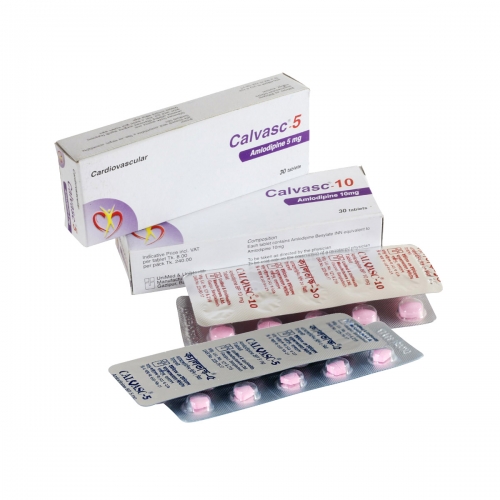ঔষধের বিস্তারিত বা বিকল্প ঔষধ জানতে ঔষধের নাম দিয়ে সার্চ দিন। যেমন- Napa বা Alatrol বা Amodis
Calvasc 10mg
TabletAmlodipine
Unimed Unihealth MFG. Ltd
Other Strength:
- Calvasc 5mg
Alternative:
- Amdocal 10mg
- Camlodin 10mg
- Amdin 10mg

Calvasc
Presentation
Calvasc-5 tablet: Deep pink, shield shaped tablet; each tablet contains Amlodipine Besylate INN equivalent to Amlodipine 5mg.
Calvasc-10 tablet: Deep pink, barrel shaped tablet; each tablet contains Amlodipine Besylate INN equivalent to Amlodipine 10mg.
Indications
Hypertension. Prophylaxis of chronic stable angina pectoris. PrinzmetalÕs (variant) angina when diagnosed by a cardiologist. In hypertensive patients, amlodipine has been used in combination with a thiazide diuretic, alpha blocker, beta-adrenoceptor blocking agent, or an angiotensin converting enzyme inhibitor. For angina, amlodipine may be used as monotherapy or in combination with other antianginal drugs in patients with angina that is refractory to nitrates and/or adequate doses of beta blockers. Amlodipine is well tolerated in patients with heart failure and a history of hypertension of ischaemic heart disease.
Dosage and administration
In adults: For both hypertension and angina the usual initial dose is 5mg amlodipine (one Calvasc- 5 tablet) once daily which may be increased to a maximum dose of 10mg (one Calvasc-10 tablet) depending on the individual patientÕs response. No dose adjustment of amlodipine is required upon concomitant administration of thiazide diuretics, beta blockers, and angiotensin-converting enzyme inhibitors.
Use in children: Not recommended.
Use in the elderly: Amlodipine, used at similar doses in elderly or younger patients, is equally well tolerated. Therefore normal dosage regimens are recommended. Patients with hepatic impairment: As with all calcium antagonists, amlodipine’s half-life is prolonged in patients with impaired liver function and dosage recommendations have not been established. The drug should therefore be administered with caution in these patients. Patients with renal impairment: Changes in amlodipine plasma concentrations are not correlated with degree of renal impairment, therefore the normal dosage is recommended. Amlodipine is not dialysable.
Contra-indications, warnings, etc.
Contra-indications: Amlodipine is contra-indicated in patients with a known sensitivity to dihydropyridines. Amlodipine should not be used in cardiogenic shock, clinically significant aortic stenosis, unstable angina (excluding PrinzmetalÕs angina). Pregnancy and lactation.
Precautions: There are no data to support the use of amlodipine alone, during or within one month of a myocardial infarction. The safety and efficacy of amlodipine in hypertensive crisis has not been established.
Drug interactions: Amlodipine has been safely administered with thiazide diuretics, alpha blockers, beta blockers, angiotensin-converting enzyme inhibitors, long-acting nitrates, sublingual glyceryl trinitrate, non-steroidal anti-inflammatory drugs, antibiotics, and oral hypoglycaemic drugs. Pharmacokinetic studies with cyclosporin have demonstrated that amlodipine does not significantly alter the pharmacokinetics of cyclosporin. Special studies have indicated that the coadministration of amlodipine with digoxin did not change serum digoxin levels or digoxin renal clearance in normal volunteers, and that co-administration of cimetidine did not alter the pharmacokinetics of amlodipine. In healthy male volunteers, the co-administration of amlodipine does not significantly alter the effect of warfarin on prothrombin response time. In vitro data from studies with human plasma, indicate that amlodipine has no effect on protein binding of digoxin, phenytoin, warfarin or indomethacin.
Use in pregnancy and lactation: There is no clinical experience with the preparation in pregnancy or lactation. Accordingly, amlodipine should not be administered during pregnancy, or lactation, or to women of childbearing potential unless effective contraception is used.
Effects on ability to drive and use machines: Clinical experience with amlodipine indicates that therapy is unlikely to impair a patientÕs ability to drive or use machinery.
Side-effects: The most commonly reported side-effects of amlodipine are headache, oedema, rash, fatigue, nausea, flushing and dizziness. Gingival hyperplasia has been reported after amlodipine. The following adverse reactions have been reported rarely: pruritus, palpitations, dyspnoea, abdominal pain, dyspepsia, muscle cramps, asthenia, somnolence, altered bowel habit, myalgia, arthralgia, mood changes, increased urinary frequency, impotence and visual disturbances. The following adverse reactions have been reported very rarely: abnormal liver function tests, jaundice, erythema multiforme and gynaecomastia. As with other calcium channel blockers the following adverse events have been rarely reported and cannot be distinguished from the natural history of the underlying disease: myocardial infarction, arrhythmia (including ventricular tachycardia and atrial fibrillation) and chest pain.
Overdose: In humans, experience with intentional overdose is limited. Gastric lavage may be worthwhile in some cases. Available data suggest that gross overdosage could result in excessive peripheral vasodilatation with subsequent marked and probably prolonged systemic hypotension. Clinically significant hypotension due to amlodipine overdosage calls for active cardiovascular support including frequent monitoring of cardiac and respiratory function, elevation of extremities, and attention to circulating fluid volume and urine output. A vasoconstrictor may be helpful in restoring vascular tone and blood pressure, provided that there is no contra-indication to its use. Intravenous calcium gluconate may be beneficial in reversing the effects of calcium channel blockade. Since amlodipine is highly protein-bound, dialysis is not likely to be of benefit.
Pharmaceutical precautions
Store in a cool and dry place, protected from light.
Packaging quantities
Calvasc-5 tablet: Carton containing 30 tablets in bottle.
Calvasc-10 tablet: Carton containing 30 tablets in bottle.
এই পাতাটি ২৬২ বার দেখা হয়েছে
রাজডক কী?
ফ্রী সদস্য হোন Click Here
ডাক্তার হিসাবে যোগদান করতে Click Here
নার্স / টেকনোলজিস্ট হিসাবে যোগদান করতে Click Here
ফ্রী সদস্য হোন Click Here
ডাক্তার হিসাবে যোগদান করতে Click Here
নার্স / টেকনোলজিস্ট হিসাবে যোগদান করতে Click Here

